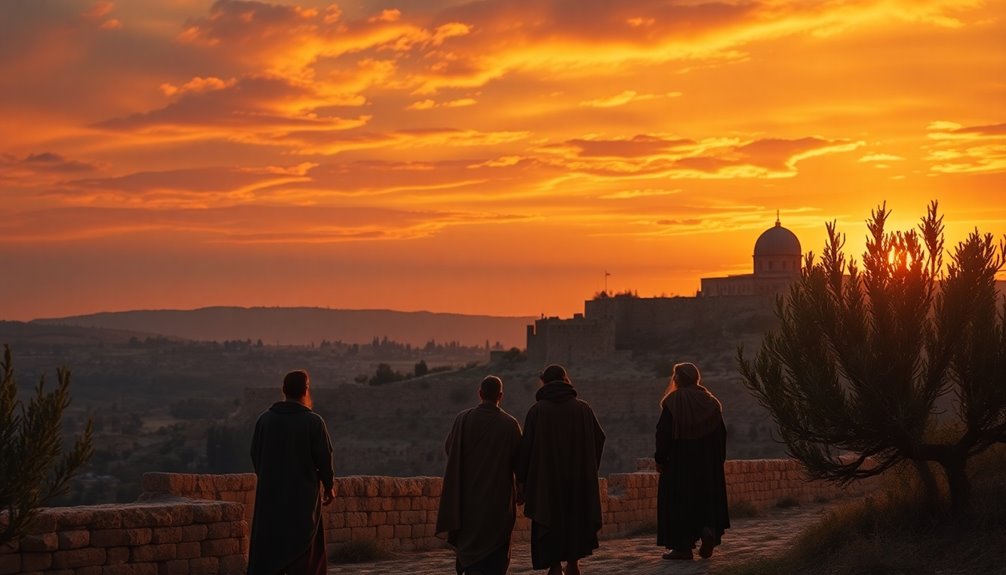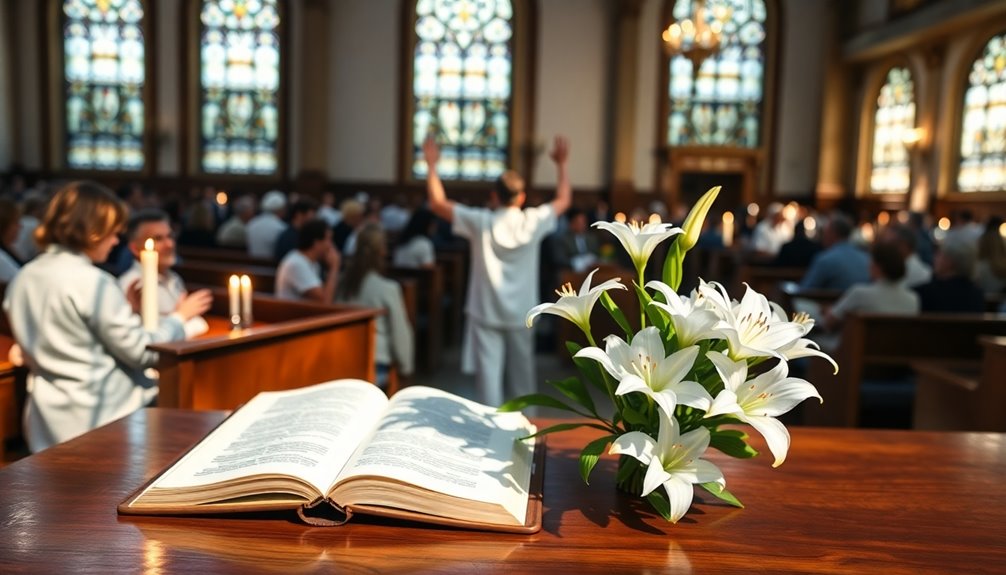When Jesus comes back, it's called the Second Coming. This significant event in Christian belief marks His glorious return to establish His kingdom. You'll see it described in scriptures like Revelation 19:11-16, where He fulfills promises to the faithful. Many also recognize the Rapture, where believers are caught up to meet Him, as an essential part of eschatology. This belief offers hope and purpose in life, encouraging spiritual readiness. There's a lot to explore about the differences between the Second Coming and the Rapture, as well as their impacts on your faith and community.
Key Takeaways
- The event of Jesus' return is primarily known as the Second Coming in Christian theology.
- The Rapture refers to believers being caught up to meet Jesus before or during the end times.
- Revelation 19:11-16 describes the Second Coming, where Jesus establishes His kingdom.
- The Rapture is detailed in 1 Thessalonians 4:13-18, emphasizing a sudden gathering of believers.
- Both events are distinct, with the Second Coming marking the end of the Tribulation period.
Introduction

The anticipation surrounding the return of Jesus, known as the Second Coming, is a cornerstone of Christian belief. This event promises a dramatic and glorious return, as described in the Word of God.
You'll find that the Second Coming is distinct from the Rapture, where believers are gathered to meet Jesus in the air. While the Rapture is often viewed as a more private event, the Second Coming is characterized by visible manifestations that everyone will witness.
According to biblical passages like Revelation 19:11-16, Jesus will come back to establish His kingdom, bringing an end to the Tribulation period outlined in texts such as Matthew 24 and Revelation 6-19.
During this tumultuous time, the faithful hold on to the hope of the resurrection of the dead, which is a key aspect of the Second Coming. The Church eagerly awaits this fulfillment of scripture, knowing that Jesus' return will usher in a new era of peace and righteousness.
As you delve deeper into this pivotal event, you'll discover how it shapes the beliefs and hopes of Christians worldwide.
Scriptural Basis for Rapture

When it comes to the Rapture, key Bible verses provide a solid foundation for understanding this event.
You'll find primary references like 1 Thessalonians 4:13-18, which paints a vivid picture of believers being caught up to meet the Lord.
Additionally, secondary passages like Matthew 24:37-40 highlight the suddenness of this occurrence, drawing parallels to the days of Noah.
Primary Bible References
Numerous biblical passages provide a foundation for the concept of the Rapture, emphasizing both the promise of resurrection and transformation.
In 1 Thessalonians 4:13-18, Paul describes how the dead in Christ will rise first, followed by living believers who'll be transformed to meet the Lord in the air. This vivid imagery encapsulates the hope of the Rapture during the second coming of Jesus.
1 Corinthians 15:50-54 further explains this transformation, clarifying that flesh and blood can't inherit the kingdom of God.
Jesus also reassures His followers in John 14:1-3, promising to return and gather them to Himself, establishing a direct connection to the Rapture.
Matthew 24:37-40 illustrates the suddenness of the event, likening it to the days of Noah, where some are taken while others remain.
Additionally, Revelation 3:10 highlights the promise to keep faithful believers from the hour of trial, interpreted by many as a reference to the Rapture prior to the tribulation period.
These passages collectively affirm the hope and anticipation surrounding the coming of the Lord and His promise to gather His followers.
Secondary Bible References
Building on the primary biblical references, secondary scriptures further reinforce the concept of the Rapture. In 1 Corinthians 15:51-52, Paul reveals a mystery that believers will be transformed in an instant at the last trumpet. This sudden transformation aligns with the idea that Jesus Christ will return unexpectedly.
Matthew 24:40-41 illustrates a separation, where one person is taken and another left behind, often interpreted as a depiction of the Rapture.
Revelation 3:10 is another key verse, promising that faithful believers will be kept from the hour of trial, which many understand as protection during the period of tribulation. This verse offers a glimpse of the blessed hope that the Rapture provides to those who trust in Christ.
Additionally, John 14:1-3 strengthens this anticipation, as Jesus assures His followers that He'll return to gather them to Himself.
Together, these secondary references provide a clearer picture of the Rapture, emphasizing the promise that Jesus Christ will return for His faithful, offering hope and assurance in uncertain times. They paint a compelling narrative of what lies ahead for believers.
First-Century Jewish Expectations

First-century Jews held a variety of expectations regarding the Messiah, envisioning a powerful leader who'd restore Israel's sovereignty and defeat its oppressors. These hopes were deeply rooted in their longing for liberation from Roman rule. Many believed the Messiah would usher in a transformative Messianic age, bringing peace and righteousness as foretold in prophecies from Isaiah and Jeremiah.
The concept of the Messiah was complex, with some anticipating a dual figure: a suffering servant alongside a conquering king. This diversity in interpretation reflected the rich tapestry of beliefs among the Jewish people. Influenced by apocalyptic literature, they were filled with expectations of imminent divine intervention, where God's kingdom would be established on earth.
Moreover, the notion of resurrection played a significant role in these expectations. Many Jews anticipated a future resurrection of the dead, aligning their hopes with the promise of the return of Christ and the Jesus second coming.
In this context, the Messiah symbolized not just a political savior but a spiritual one, embodying the community's deepest aspirations for liberation, justice, and eternal life.
Rapture's Impact on Believers

The belief in the Rapture profoundly shapes the lives of many Christians, offering them a sense of hope and purpose amid life's challenges. For you, the Rapture signifies a moment of deliverance when Jesus returns to take faithful believers to be with Him, providing comfort in the face of tribulation. This anticipation encourages you to lead a holy life, reminding you of the importance of spiritual readiness as the second coming draws near.
You may feel a sense of urgency to share your faith with others, believing that time is limited before the Rapture occurs. This shared expectation fosters a strong community among Christian believers, uniting you and others in the hope of being together with Christ and fellow believers in the afterlife.
While some might experience anxiety about the fate of non-believers or fear of abandonment, many find reassurance in the promise of salvation and eternal life.
Ultimately, the belief in the Rapture instills a profound hope that shapes your actions, attitudes, and relationships, reinforcing the commitment to live in anticipation of Jesus returning.
Misunderstandings About the Rapture

You might be surprised to learn that many common beliefs about the Rapture are based on misconceptions.
For instance, the idea that it's a secret event contradicts biblical texts that highlight Christ's visible return.
Debunk Rapture Misconceptions
Misconceptions about the rapture can lead to confusion and fear among believers. One common myth is the idea of a "secret rapture," where followers of Christ vanish unnoticed. However, scripture contradicts this notion; Revelation 1:7 clearly states that Jesus' return will be visible to all.
The belief in a pre-tribulation rapture, popularized by John Nelson Darby in the 19th century, lacks historical support from early church teachings. Notably, influential Christian leaders like John Bunyan and Martin Luther supported post-tribulation views, emphasizing that the antichrist must be revealed before Christ's second coming (2 Thessalonians 2:1-3).
Matthew 24:37-42 uses the days of Noah as a metaphor, indicating that those taken away may not be the saved. Instead, they resemble the lost. This perspective aligns with the idea that, during the great day of the Lord, believers will be caught up together with Christ, but only after enduring tribulation.
Sorting through these rapture misconceptions can provide clarity and peace, reminding you that the return of Christ is a profound event, not a hidden escapade.
Timing of the Rapture
When discussing the timing of the Rapture, Christians often find themselves divided among various interpretations. Some hold to a pre-tribulation view, believing the Rapture occurs before the tribulation, as suggested in 1 Thessalonians 5:9. They argue that believers aren't destined for wrath and will be taken up prior to the day of the Lord.
Other Christian denominations contend that the Rapture and the Second Coming are one event, referencing Matthew 24:37-40, which speaks of the days of Noah and suggests a singular occurrence.
Critics of the pre-tribulation perspective point to 2 Thessalonians 2:1-3, which indicates that the revelation of the antichrist must occur before the Rapture. This interpretation suggests that believers will face tribulation before being gathered.
Unfortunately, these misunderstandings about the timing of the Rapture have caused anxiety and confusion within the Christian community, especially after failed predictions of its occurrence.
Navigating these differing views can be challenging, but understanding the scriptural basis for each interpretation helps clarify where you stand in this complex discussion.
Faith in Daily Life

In your daily life, practicing faith through prayer and scripture can bring clarity and strength during challenging times.
Engaging with your faith community offers support and connection that can enhance your spiritual journey.
Together, these practices help you stay grounded and live out your beliefs in meaningful ways.
Daily Spiritual Practices
Daily spiritual practices are essential for nurturing your relationship with Jesus and navigating life's challenges. Incorporating these practices into your daily routine helps you stay grounded in your faith.
Start with prayer; it deepens your connection with God and allows you to seek guidance for any situation you face. Regular Bible reading is crucial too, as it helps you understand God's Word and the teachings of Jesus, offering wisdom for your everyday decisions.
Engaging with your community is another vital aspect. Participating in communal worship and fellowship strengthens your bonds with fellow believers, creating a supportive environment that encourages spiritual growth and accountability.
Don't forget the importance of gratitude; journaling or reflecting on your blessings can shift your perspective and open your heart to recognize God's work in your life.
Finally, consider service. Acts of kindness or volunteering fulfill Jesus' teachings on love and compassion, reminding you to live out your faith in tangible ways.
Congregational Support Initiatives
Building on the importance of daily spiritual practices, congregational support initiatives play a vital role in integrating faith into everyday life. These initiatives offer valuable resources and programs that encourage your spiritual growth and community engagement.
Many churches organize small group studies and workshops, helping you apply biblical teachings to real-world situations. This fosters a deeper understanding of how to live your faith daily.
Outreach programs are essential, too, as they focus on serving the local community through acts of service and compassion. By participating, you actively live out your faith, making a tangible difference in the lives of others.
Additionally, mentorship programs connect seasoned members with newer attendees, guiding them on their spiritual journeys and enhancing personal connections.
Regular events, like prayer meetings and Bible studies, strengthen congregational ties, creating a supportive environment where you can share your experiences and challenges.
These gatherings not only deepen your faith but also build a sense of belonging. Through congregational support initiatives, you're empowered to engage with your faith meaningfully, impacting both your life and your community.
Eschatological Perspectives on Rapture

Frequently, discussions about eschatology focus on the Rapture, a belief that Jesus will return to gather His followers. This event, derived from the Greek word "harpazo," means to seize or snatch away. Many believers differentiate the Rapture from the Second Coming, viewing it as a separate occurrence.
Premillennialists often support the idea of a pre-tribulation Rapture, which suggests that Jesus returns before a period of tribulation. This perspective gained traction in the 19th century, thanks in part to John Nelson Darby and popular culture representations like the "Left Behind" series.
However, not everyone agrees on the timing of the Rapture. Some interpret it as occurring mid-tribulation or post-tribulation, leading to various eschatological implications and questions about theology.
Critics of Rapture theology raise concerns about the psychological effects on believers, particularly the anxiety and fear stemming from predictions about the end times. These differing viewpoints create a rich tapestry of beliefs surrounding the Rapture.
As you explore these perspectives, consider how they shape your understanding of the hope and anticipation surrounding Jesus' return.
Additional Resources

To deepen your understanding of the Second Coming and the Rapture, exploring additional resources can be incredibly beneficial. You might start by diving into key biblical passages in the New Testament. For instance, Revelation 19:11-16 vividly describes how Christ returns in glory to judge and restore, while Matthew 24:27 emphasizes the visibility of Jesus coming, comparing it to lightning flashing across the sky.
Consider reading theological texts that differentiate between the Rapture and the Second Coming. Many sources clarify that the Rapture is often seen as a separate event where believers meet the Lord in the air before the Great Tribulation begins. You'll find that interpretations vary significantly across Christian denominations.
Pretribulational rapture views are popular among American Fundamentalist groups, whereas many mainstream denominations reject the idea of a separate Rapture altogether.
Podcasts and lectures from theologians can also provide insights into these complex topics. By engaging with various perspectives, you'll gain a richer understanding of what happens when the Lord will come and how believers interpret these pivotal events in Christian eschatology.
Frequently Asked Questions
What Is It Called When Jesus Returns?
When you think about Jesus' return, you might call it the Second Coming. This significant event represents His triumphant return to establish His kingdom and defeat evil.
Some also refer to the moment when believers are taken up as the Rapture, highlighting the gathering of the faithful.
The biblical passages emphasize that His return will be public and glorious, much like lightning illuminating the sky, marking a pivotal moment in history.
What Is the Word That Means Jesus Is Coming Back?
The word that means Jesus is coming back is often referred to as the "Second Coming." This term captures the essence of His anticipated return to fulfill prophecies and establish His kingdom.
You might also hear "Parousia," which emphasizes His presence and arrival. Additionally, "Rapture" describes the moment believers are taken up to meet Him, while "Epiphaneia" signifies His manifestation at that time.
Each term reflects different aspects of this significant event.
What Is It Called After Jesus Comes Back?
After Jesus comes back, you'll see the establishment of the Messianic Kingdom, often referred to as the Millennium.
This is when Christ reigns for a thousand years, defeating evil and restoring order.
Following this period, the Great Tribulation occurs, leading to a final judgment where the righteous are rewarded, and the wicked face consequences.
Ultimately, you'll witness the creation of a New Heaven and New Earth, where God dwells with His people forever.
What Was It Called When Jesus Came Back to Life?
When Jesus came back to life, that event's referred to as the Resurrection. It happened on the third day after His crucifixion, showcasing His victory over sin and death.
You can find accounts of this miraculous event in the Gospels of Matthew, Mark, Luke, and John.
Celebrated annually on Easter Sunday, the Resurrection is central to the Christian faith, emphasizing the hope and promise of eternal life through Him.










